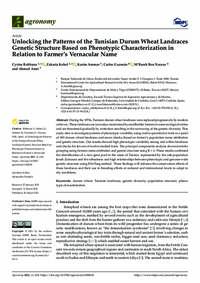Unlocking the Patterns of the Tunisian Durum Wheat Landraces Genetic Structure Based on Phenotypic Characterization in Relation to Farmer’s Vernacular Name

Authors:
During the 1970s, Tunisian durum wheat landraces were replaced progressively by modern cultivars. These landraces are nowadays maintained by smallholder farmers in some ecological niches and are threatened gradually by extinction resulting in the narrowing of the genetic diversity. This study aims to investigate patterns of phenotypic variability using twelve quantitative traits in a panel of 189 durum wheat landraces and seven checks, based on farmer's population name attribution and genetic structure. Our results showed high phenotypic variability among and within landraces and checks for ten out of twelve studied traits. The principal components analysis showed similar grouping using farmers name attribution and genetic structure using K = 6. These results confirmed the identification of a new gene pool in the oases of Tunisia, represented by the sub-population Jenah Zarzoura and the robustness and high relationships between phenotypic and genome-wide genetic structure using DArTseq method. These findings will enhance the conservation efforts of these landraces and their use in breeding efforts at national and international levels to adapt to dry conditions.
